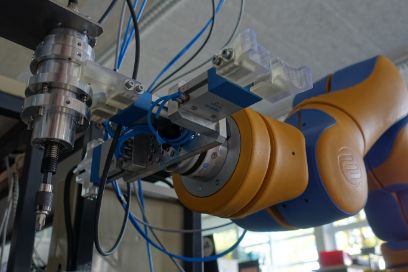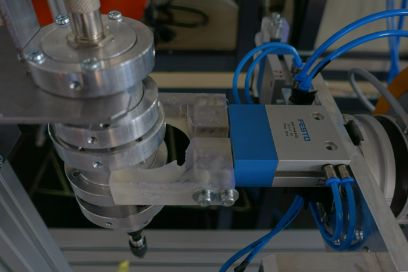- Research Project
Flexible assembly with robots
If a robot is able to grip a wide variety of objects and use tools skilfully, it should be profitable to use such a robot to automate production processes even for smaller batch sizes. But how feasible is a robot for flexibly configurable assembly lines?
Factsheet
- Lead school(s) School of Engineering and Computer Science
- Duration (planned) 01.06.2018 - 28.02.2019
- Project management Norman U. Baier
- Head of project Joel Costan
-
Project staff
Joel Costan
Simon Kaderli - Keywords Automation, Robotics, Manufacturing, Assembly, Production Process
Initial situation
One of the reasons why robotics is rarely used with small quantities and in smaller companies is the inevitable need for a specialist whose job it generally is to program the robot. If a company only has individual production lines, the specialist may not have enough work to keep busy, and it may not be profitable to assign him to other positions.
There are also technical reasons why robotics has not yet become widespread for small batch sizes. A human worker can reliably grasp a wide variety of objects with his hands, which is essential in more complex manufacturing processes. If the worker’s hands are not up to a task, he opts for tools such as electric screwdrivers.
Goals
What would flexible assembly with a robot look like? The goal of the project was to answer this question. And if the robot is to be used for small batch sizes, the basic programming should be performed automatically. The robot should also be able to use tools in the same skilled way a person does.
From the idea to the implementation
The implementation was carried out with a P-Rob 2 from F&P Robotics AG with Solid Edge software from Siemens PLM Software Inc. A force-torque sensor from OnRobot A/S was also used. The computer running Solid Edge simultaneously acts as the interface to the P-Rob 2, which receives its commands via an Ethernet connection. The robot was programmed using the robot’s own programming environment myP, which is based on Python. The interface between Solid Edge and P-Rob 2 is controlled by a program written in the high-level language C#. A gearing mechanism consisting of gear wheels, cover and screws was chosen as the object to be assembled.

Creation of the CAD assembly
To assemble an object requires the creation of a corresponding CAD assembly in Solid Edge, which at present still calls for a certain amount of initial effort. The path planning uses a sequence of intermediate positions that are stored in an ‘alternative assembly’. In the simplest case, the component to be manufactured is assembled linearly. Where the robot motion sequences are more complex, multiple intermediate positions must first be defined.
When creating the drawing, the designer specifies the sequence in which the parts are assembled and indicates intermediate positions to ensure that the process paths will be collision-free.

Automated assembly
The P-Rob 2 is available with two servo finger grippers that enable versatile gripping. In practice it turned out that although the gripping function is indeed versatile, there is a relatively wide variance in the actual gripping motion. This means that even if the parts are provided individually, the precise position of the gripped part cannot be calculated accurately enough to guarantee a reliable manufacturing process. Because of this, the current version uses a specially manufactured head incorporating multiple pneumatic grippers.
A force-torque sensor was used to mount shafts and meshing gears. The placement and rotation of a gear until it engages is performed in this case by the C# program, and not specified by the designer. An electric screwdriver with a magnetic bit holder is used for screwing housing covers together. This allows the screws to be picked up and screwed in directly.
Current state of progress
The initial impulse that led to the development of this system was the fact that many electrical circuit boards are still assembled by hand with wired components in small batch sizes. At the current stage of development, it is not possible to grip wired components. It is an anachronism for which there is currently no solution available. In such cases, we recommend examining whether surface-mounted components and a placement machine can be integrated into the process. On the other hand, the system is easily able to handle the final assembly of equipment that consists of ready-assembled circuit boards, axles and gears. This also applies to drives, amplifiers, inverters and other mechatronic units.


